Washing car engine can feel risky, especially if you are worried about damaging important parts like the alternator, air intake, or electrical wires. These are sensitive spots and should be kept safe while cleaning. Dust, grease, and oil can make it look dirty and cover up problems like oil leaks. No need to stress, learning how to wash a car engine safely is simpler than you think. This guide will show you exactly what to do to keep your engine clean without causing any harm.
Is Washing Car Engine Safe?
Many car owners wonder if spraying water under the hood is a good idea. Being honest, it is safe to wash your car engine, but you need to be careful and follow the right steps. Modern engines are built to handle some moisture, but that does not mean you can freely spray water directly onto wires or connectors. A gentle rinse is usually fine.
Can water damage your car engine? Yes, if you are not careful. Using too much water pressure or the wrong cleaning method can cause damage or start creating issues. Is it safe to spray your engine with water? To stay safe, a soft spray is acceptable, use engine-safe products, and protect key parts before you begin. With some care, cleaning your engine is a safe and smart part of car maintenance.
Essential Tools You Need
Before you start, get your tools ready. This makes the job easier and faster.
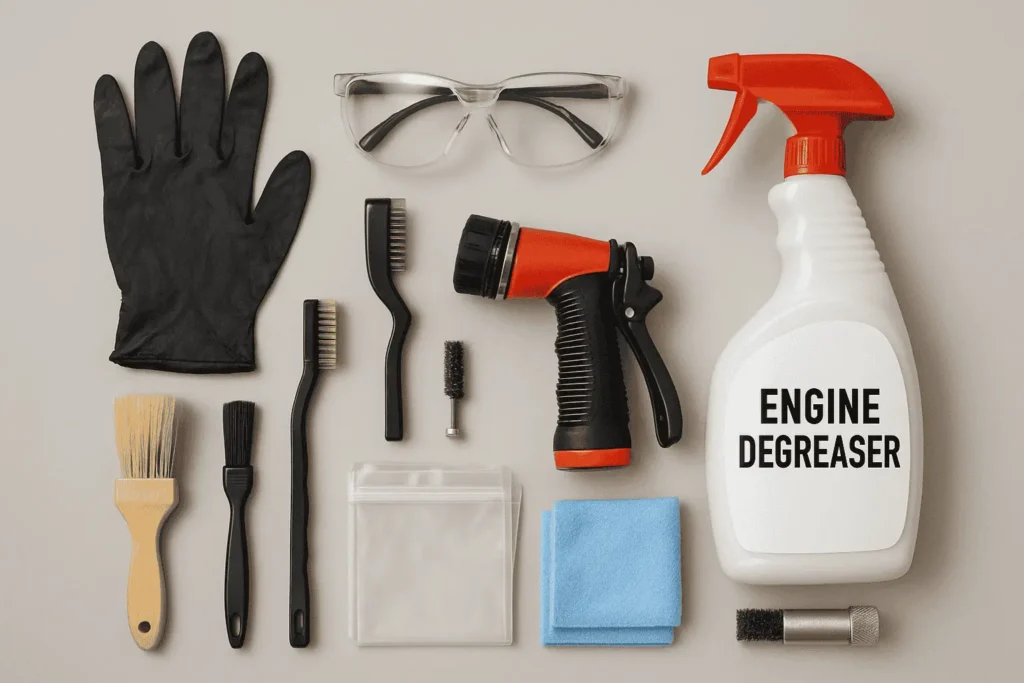
- Safety Gear: Wear gloves and eye protection. This keeps your hands and eyes safe from cleaning liquids and dirt.
- Engine Degreaser: This special cleaner removes dirt, oil, and grease. Ensure to choose one made for car engines.
- Brushes: You will need brushes of different sizes. A big brush for tough dirt and smaller ones for tight spots.
- Water Hose: A regular garden hose with a gentle spray nozzle is best for rinsing. Try to avoid a pressure washer, as strong water can cause damage.
- Plastic Bags or Wrap: These are most important! Use them to cover sensitive electrical parts like the battery, air filter, and wires. This blocks water and keeps things dry and safe.
- Soft Cloths: Microfiber cloths or old towels are great for drying and wiping.
- Battery Brush (Optional): If you want to clean your battery terminals, you will need this.
- Air Blower (Optional): An air compressor can help dry hard-to-reach areas.
Steps for Washing Car Engine
Follow these simple steps to clean your engine bay safely and well. Take your time and be careful.
Step 1: Get Ready and Stay Safe
Always start with a cool engine. A hot engine can make cleaners dry too fast and leave marks. It can also burn you. Park your car on flat ground. Disconnect the negative cable from your car battery. This stops any electrical problems while you clean. This is a very important safety step.
Step 2: Cover Sensitive Parts
This is the most important part. Use plastic bags or wrap to cover all sensitive electrical parts. This includes the alternator, any exposed wires, and the air intake. Tie the plastic tightly with rubber bands or tape. This prevents water from getting in and damaging these delicate parts.

Step 3: Remove Loose Dirt
Before using any liquids, use a brush or air to remove loose leaves, dirt, or large debris. This helps the cleaner work more efficiently.
Step 4: Spray Engine Degreaser
Spray the engine degreaser all over the engine bay. Focus on areas with a lot of dirt, oil, and grease. Let it sit for about 10-15 minutes, or follow the instructions on the product. Make sure it does not dry on the engine.
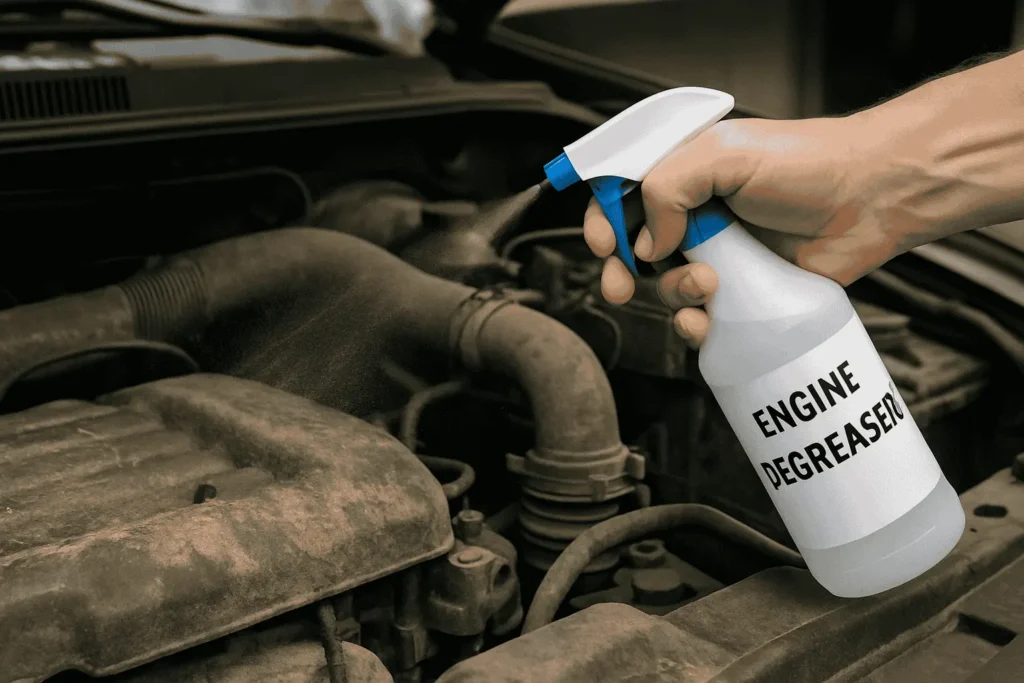
Step 5: Scrub Away Dirt
Use your brushes to scrub the cleaner on all surfaces. Scrub hard on tough dirt areas. Do not forget the tight spots. If some areas still look very dirty, spray more cleaner and scrub again.
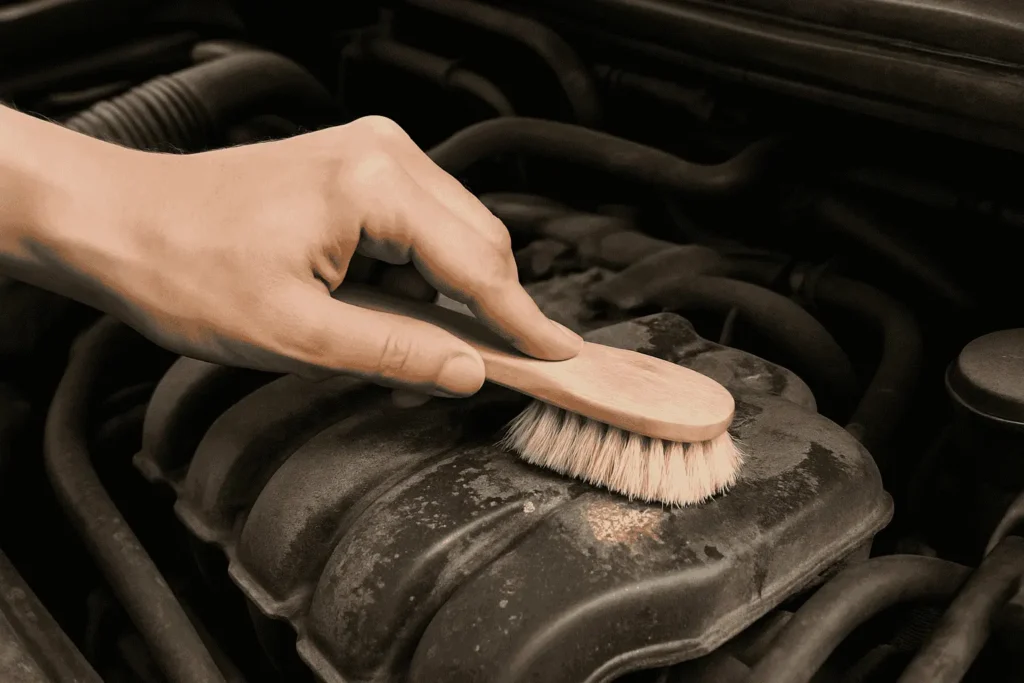
Step 6: Rinse Gently
Be very careful here. Use your garden hose with a gentle spray. Rinse off the cleaner and dirt. Do not spray strong water directly onto covered electrical parts. Rinse the surfaces softly with water. A gentle rinse is enough.
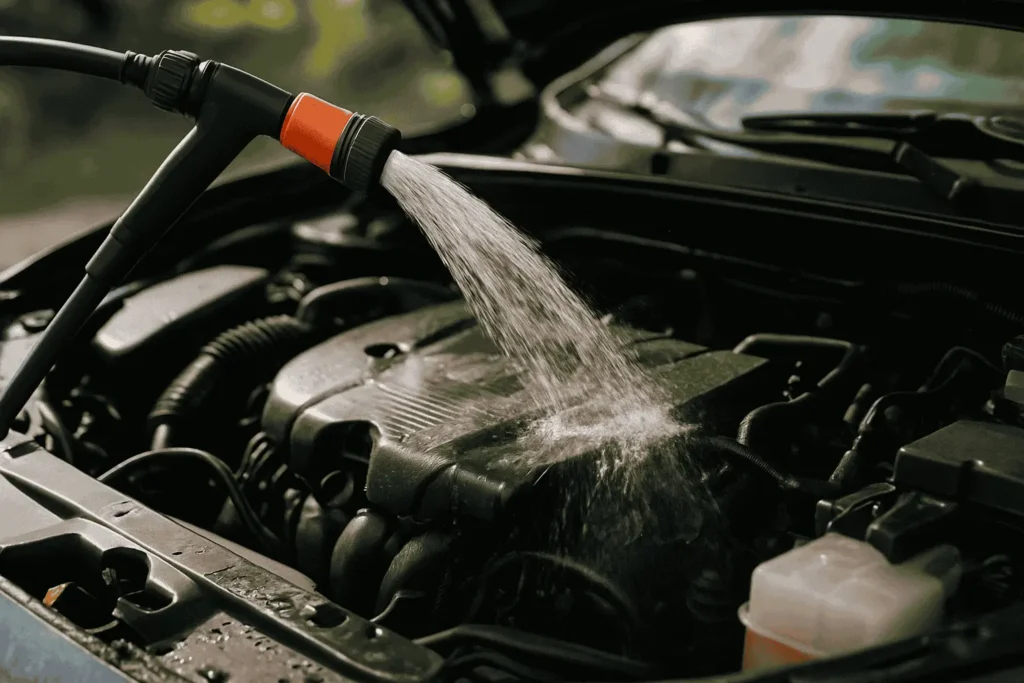
Step 7: Dry the Engine Bay
After rinsing, take off the plastic covers. Dry all reachable parts using a soft cloth. An air blower can help get water out of small spaces. Let the engine air dry completely for a few hours or overnight, before connecting the battery. This stops moisture from causing rust or electrical issues.
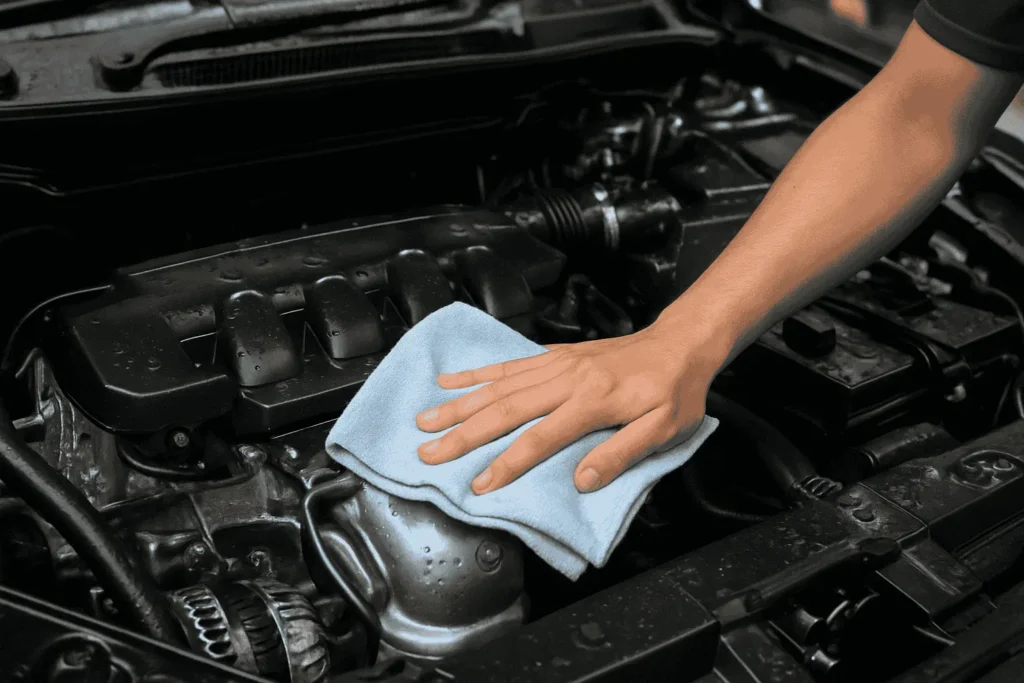
Step 8: Final Check
Once the engine bay is totally dry, connect the negative battery cable again. You can put a special dressing on plastic and rubber parts to make them look new. Now that the engine is clean, take a moment to check for new oil leaks or problems. Regular cleaning helps clean your car running well.
Avoid Common Mistakes
While cleaning your engine can help it look better and even run smoother, it is dangerous if you do it the wrong way.
- The biggest danger is water getting into electrical parts, which can cause problems with your car electrical system.
- Using a strong pressure washer might push water into tight areas, leading to rust or short circuits.
- If you do not dry the engine well, trapped water can cause corrosion over time.
- Another major mistake is harsh cleaners, they can harm rubber hoses, plastic parts, and painted areas.
So, it is important to be gentle, use the right products, and follow the safe steps. If done with care, engine cleaning is helpful and if done the wrong way, it can cause more harm than good.
When to Get Professional Help
Cleaning your car engine yourself can be safe and effective. But if you are not comfortable, it is better to get help from a professional. Experts have the right tools, products, and experience to clean your engine thoroughly and safely. They can also spot early signs of leaks, or other issues that you might overlook. They often use methods like steam cleaning, which uses less water and is safer for sensitive parts. It can save you time, and help keep your car in top shape.

Conclusion
Cleaning your car engine is a valuable task. It helps your car run better, last longer. If you use the proper tools, protect key parts, and follow safe methods, you can get a clean engine bay without any trouble. Either you do it by yourself or hire a professional, regular engine cleaning is a smart habit that makes a big difference for your car. With the right care, your engine will stay in great condition, that means a smoother and more reliable ride. A clean engine is a happy engine!
Is it okay to wash the engine of a car?
Yes, it is okay to wash your car engine. Just be gentle with water pressure and avoid spraying directly on sensitive electrical parts, especially in older cars.
What is the best way to clean my car engine?
Start with a cool engine. Cover electrical parts, apply a degreaser, scrub with a brush, and rinse gently using a garden hose. Avoid high-pressure washers.
Can I wash my engine car with water?
Yes, you can. Just use low-pressure water and never wash a hot engine. Cold engines are safer and easier to clean without damaging anything.
Will water damage your engine?
Water can damage the engine if it gets inside the air intake or oil system. Always be careful and avoid soaking electrical areas or filters.
Can engine washing improve performance?
Yes, a clean engine can help parts run cooler and more efficiently. It also prevents grime buildup that may affect fuel economy or cause damage over time.
What are the disadvantages of washing the engine?
If not done properly, water can cause issues like starting problems or damage to nearby electrical parts. Always cover sensitive areas before washing.
Why do cars run better after a car wash?
A clean car reduces air drag, which helps the engine work a little less. It might even give you better fuel efficiency over time.
Does driving fast clean your engine?
No, driving fast does not clean your engine. If your engine is dirty inside, you will need proper cleaning or a professional service to fix that.
